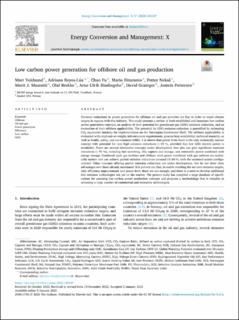| dc.description.abstract | Emission reductions in power generation for offshore oil and gas activities are key in order to reach climate targets in regions with this industry. This study presents a review of both established and immature low carbon power generation concepts, an analysis of their potential for greenhouse gas (GHG) emission reduction, and an evaluation of their offshore applicability. The potential for GHG emission reduction is quantified by estimating CO2 equivalent intensity for implementation on the Norwegian Continental Shelf. The offshore applicability is evaluated with emphasis on weight, infrastructure requirements, process heat availability, technical maturity, as well as health, safety, and environment (HSE). It is shown that power from shore is the only technically mature concept with potential for very high emission reductions (>95 %, provided that low GHG electric power is available). There are several alternative concepts under development that also can give significant emission reductions (>70 %), including fuel switching, CO2 capture and storage, and renewable power combined with energy storage. Combined cycle gas turbines and offshore wind power combined with gas turbines are technically mature and can achieve partial emission reductions (around 15–50 %, with the assumed system configurations). Other concepts offering partial emission reductions are under development, but do not show clear advantages over those already mentioned. It is pointed out that, to enable reaching the net zero emission targets, only efficiency improvements and power from shore are not enough, and there is a need to develop additional low emission technologies not yet on the market. The present study has compiled a large database of specifications for assessing low carbon power production concepts and proposes a methodology that is valuable in screening a large number of commercial and immature technologies. | en_US |

